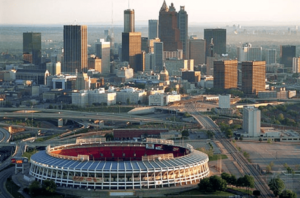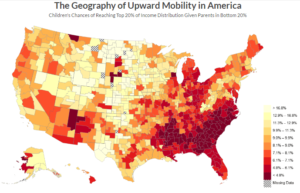
Atlanta (Source: Wikimedia Commons)
The South is booming from an economic standpoint. For proof of this, one need only look at cities such as Atlanta, Austin, Charlotte, Dallas, Orlando and Raleigh to understand there is a new South. Of the 20 cities listed on Forbes’ “fastest-growing cities in 2016” list, eight are in the South. Despite this reality, poor people in the South are not sharing in this growth. It is in Dixie — the former Confederacy, the Jim Crow states — where children have the toughest chance of getting ahead. This is where people have the lowest levels of economic mobility, also commonly known as the American Dream, meaning that the poor will likely remain poor.
Charlotte is a case in point and reflective of a larger trend throughout the region. The city, a hub for the financial services sector and the 13th-fastest-growing city according to Forbes, is not a place for the poor to thrive. There is segregation, with whites and more-affluent people living in the south of the city, and predominantly poor, Black and Latino people living in the north and west. According to the Equality of Opportunity Project, Charlotte ranks at the very bottom of America’s 50th-largest cities in terms of economic mobility. In Charlotte, children born in the bottom 20 percent of income distribution have only a 4.4-percent chance of making it to the top 20 percent of the economic ladder. This compares to 10.8 percent of children in Salt Lake City, Utah, and 12.9 percent in San Jose, Calif.

Source: The Equality of Opportunity Project
Similarly, a 2012 report from the Pew Charitable Trusts found that while eight states primarily in New England and the Mideast U.S. have higher upward mobility and lower downward mobility than the national average — Maryland, New Jersey, New York, Connecticut, Massachusetts, Pennsylvania, Michigan and Utah — nine Southern states have lower-than-average upward mobility and higher downward mobility. Those states are Louisiana, Oklahoma, South Carolina, Alabama, Florida, Kentucky, Mississippi, North Carolina and Texas.
As the Network for Southern Economic Mobility has noted, more than 50 percent of Americans living in high-poverty communities are in the South. Poverty rates are higher in the South, with one quarter of children living in poverty, as opposed to the national average of one-fifth, according to the Children’s Defense Fund. Based on federal data, Florida is the only Southern state whose minimum wage exceeds the federal lower limit of $7.25. Red states, particularly the Southern states, depend more on government than blue states. For example, a 50-state data analysis from WalletHub found that Mississippi receives about $3 for every $1 it pays in federal taxes, while Alabama and Louisiana receive slightly more than $3. Florida receives over $4.50 from the federal government for every dollar it sends to the IRS, and South Carolina receives $7.87. Yet, the former Jim Crow states tend to eschew government the most and treat their people the worst regarding health coverage, education and other measures.
The deeply impoverished in the urban centers of the Deep South find themselves out of luck and with nowhere to turn in a region where unemployment is already high and wages are low. As The Washington Post reported in 2015, the poor have been pushed out of the center of metropolitan areas and away from employment due to the rising cost of real estate and harmful government policies. Cash-assistance programs and other social safety-net measures have been decimated and the Southern poor are more likely to be single parents with no help, as five of the six states with the highest percentage of single parents are in the Deep South. Often displaced from the center of town, they rely more on public transportation, which is of the worst quality in the nation. White Southern Republicans oppose mass transit systems, keeping low income and Black people entrenched in poverty with little opportunity for advancement. Opposition to spending for infrastructure, social services and other initiatives reflects a Republican mindset against government programs under the assumption they will help Black people.

Source: USDA
The legacy of racial and economic inequality that plagues the South to this day is a testament to the enduring presence of slavery and Jim Crow segregation and a system built on the dehumanization and exploitation of Black people and the accumulation of white wealth. The South has had hundreds of years to normalize the inequality and desensitize itself to the injustices inflicted upon those of African descent, as its white elites have thwarted any attempts at unity between Black and white working-class folks.
As Alyson Zandt wrote in “Facing South,” what is wrong with the South is what is wrong with America. “What went wrong is centuries of enslavement and systemic discrimination that resulted in the immense disparities we see today — but most news stories don’t capture that context,” she said. “Our region’s history of economic dependence on free, forced labor, and then later on cheap, exploitative labor, meant there were minimal opportunities for wealth creation for those outside the economic elite, and particularly for people of color, and there has been unequal investment in community resources that are beneficial to the entire population, like schools, transportation and health care.” Even in the absence of legalized racial segregation, segregation in the South is maintained along highly demarcated lines of poverty and affluence, which are, in turn, color coded.
This is why inequality remains endemic in the South, as many Black people are left behind in the booming economy, unable to share in its fruits. Systems of oppression will continue to do what they know.


